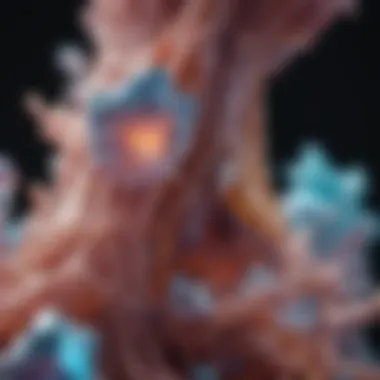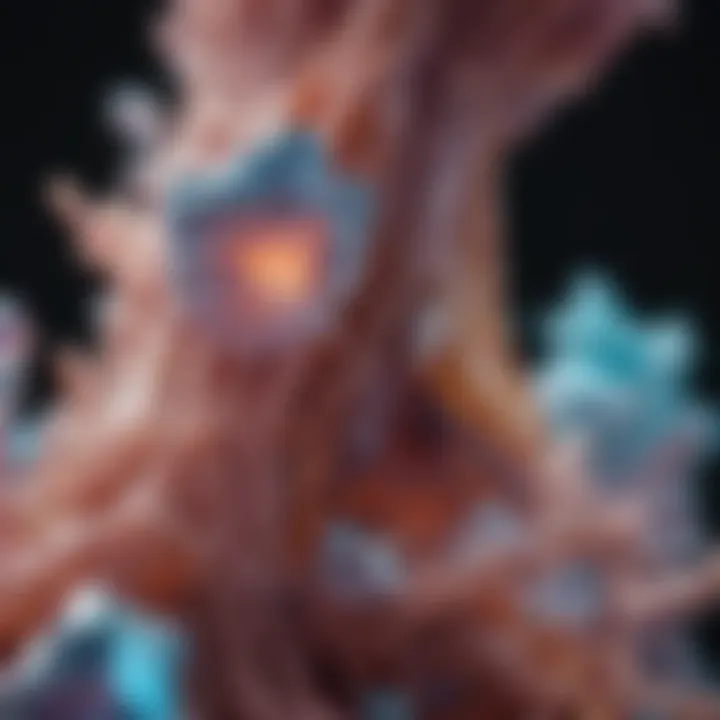Exploring Gout: Insights for Effective Management


Intro
Gout is a complex condition affecting many people worldwide. It is a type of inflammatory arthritis that results from high levels of uric acid in the blood. This buildup can cause intense pain and inflammation in the joints, leading to recurrent attacks. Despite being a well-known health issue, the nuances of gout often remain obscure to the general public and even some healthcare professionals.
Understanding the inner workings of gout is crucial for effective management. This article aims to explore the various facets of gout, including its pathophysiology, risk factors, diagnostic methods, and management strategies. By providing a thorough analysis, we hope to enhance both patient and professional awareness regarding this condition.
As we address the socio-economic consequences of gout, it becomes clear that the conversation should extend beyond individual health. Gout creates a burden not only on personal well-being but also on healthcare systems and communities. The goal is to illuminate these aspects, offering a comprehensive guide that supports informed decision-making for those affected.
Gout's prevalence is on the rise globally, making the understanding of its mechanics and treatment options all the more urgent. Through examining current research and treatment alternatives, this article will serve as a resource for students, researchers, educators, and healthcare professionals alike.
Intro to Gout
Gout is not merely a fleeting condition; it is a chronic metabolic disorder that significantly impacts many people's lives. Understanding gout is critical not just for patients who suffer from this debilitating ailment, but also for healthcare professionals who aim to provide comprehensive care. Gout primarily manifests through sudden and severe pain in the joints, often affecting the big toe. This article strives to shed light on the essential aspects of gout, including its underlying causes, how it evolves, and strategies for effective management.
The consequences of gout extend beyond the painful episodes. As such, recognizing the factors involved can lead to better health outcomes. Current research points to various elements that contribute to the risk factors of gout, including genetics, diet, and lifestyle decisions. By unpacking these components, we aim to offer valuable insights that can enhance both individual and collective understanding of this condition.
Moreover, this exploration of gout encompasses various clinical aspects, including diagnosis and management. Proper diagnosis can be the difference between effective treatment and ongoing suffering. Management strategies—ranging from medications to lifestyle modifications—play a crucial role in mitigating the effects of gout.
As we embark on this journey to understand gout, it is essential to appreciate that the condition has a rich historical context. This context shapes our current approach to diagnosis and treatment, making it vital for any serious study of gout. Let us delve deeper into what gout represents and how historical perspectives have guided its treatment over time.
Defining Gout
Gout is characterized by intense pain and inflammation in the joints, particularly during acute attacks. This condition occurs when there is an excess of uric acid in the bloodstream, leading to the formation of needle-like crystals in the joints. These crystals trigger an immune response, resulting in the classic symptoms of swelling, redness, and unbearable pain.
Uric acid is a byproduct of the breakdown of purines, substances found in many foods. While the body normally expels uric acid through urine, an overload can occur due to several reasons, including dietary choices or decreased renal function.
Historical Context
Historically, gout has often been referred to as the "disease of kings" due to its association with rich diets and lifestyles. Ancient texts describe various treatments for gout, demonstrating that it has been recognized for thousands of years. From Hippocrates to modern times, the understanding of gout has evolved significantly. Initially, it was thought to be a result of divine punishment or imbalance within the body. However, as medicine progressed, the scientific basis behind gout became clearer.
In the 19th century, advancements in chemistry enabled better understanding of uric acid and its role in gout. This led to the realization that lifestyle factors, such as alcohol consumption and dietary choices, significantly influenced the prevalence of this condition. Today, as we confront rising obesity rates and increased consumption of purine-rich foods, the historical context of gout serves as a stark reminder of the ongoing challenge presented by this condition.
Pathophysiology of Gout
The pathophysiology of gout is crucial for understanding this debilitating condition. It involves several intricate biological processes, notably how uric acid behaves in the body. Grasping this complexity is essential not only for medical professionals but also for patients who seek to better manage their symptoms. Effective management hinges on knowing the underlying mechanisms that trigger and aggravate this painful disease.
The Role of Uric Acid
Uric acid is a byproduct of purine metabolism, derived from both dietary sources and the body's cellular processes. Normally, uric acid dissolves in the blood and is excreted by the kidneys. However, when levels become excessively elevated, hyperuricemia occurs, setting the stage for gout. High concentrations of uric acid can lead to the formation of monosodium urate crystals.
In many cases, symptoms do not arise until the crystals deposit in the joints, leading to an inflammatory response. Monitoring uric acid levels can be a significant component of gout management. Recognizing when levels exceed the normal range allows potential interventions to prevent acute gout attacks.
Crystal Formation in Joints
The presence of monosodium urate crystals in the joints is a hallmark of gout. These crystals trigger intense inflammatory responses when deposited in joint spaces. The inflammation can be debilitating, often experienced as sudden and painful attacks.
The process begins when uric acid levels rise and crystals form. Once the crystals are in the joints, they activate the body's immune response. This can result in severe pain, redness, and swelling, often affecting the big toe or other joints. Understanding the conditions that favor crystal formation can help individuals make better dietary and health choices to avoid flare-ups.
Immune Response
When monosodium urate crystals accumulate in the joints, they are recognized by immune cells, leading to an inflammatory response. The immune system triggers the release of cytokines and chemokines, which amplify the inflammatory process. This response results in the symptoms associated with gout attacks—redness, heat, swelling, and severe pain.
Moreover, prolonged exposure to high levels of uric acid can result in chronic inflammation, potentially leading to joint damage over time. Awareness of the immune response mechanisms can help in the development of targeted therapies that might alleviate the painful manifestations of gout.
Understanding the pathophysiology of gout is crucial to developing effective treatment strategies and improving patient outcomes.
Risk Factors for Gout
Understanding the risk factors for gout is essential in both prevention and management of this condition. Identifying these elements allows individuals and healthcare providers to strategize effectively in reducing the incidence of acute attacks. Gout is not merely a consequence of lifestyle choices; a myriad of genetic, dietary, and lifestyle factors contribute to its emergence. Recognizing these risk factors can lead to informed decisions, thus improving outcomes for those affected.
Genetic Predispositions
Research indicates that genetics play a significant role in susceptibility to gout. Individuals with a family history of the condition are more likely to experience an onset themselves. Genetic variations can affect how effectively the body processes uric acid, leading to increased concentrations in the blood. Specific genes are linked to the renal excretion of urates, and abnormalities in these genes can heighten the risk of developing gout.


Genetic factors account for an estimated 30-60% of the risk of developing gout.
Moreover, hereditary predispositions often correlate with higher uric acid levels, which is a direct factor leading to crystal formation in joints. Understanding these genetic links is crucial for individuals who have relatives with the condition. They can actively monitor their uric acid levels and adopt preventive measures early on.
Dietary Influences
Diet is a significant contributor to gout management. Certain foods can exacerbate the condition, primarily those high in purines, which break down into uric acid. Items such as red meats, organ meats, and some seafood are known for elevating uric acid levels. Equally important are sugary beverages and alcohol, particularly beer, which have been linked to an increased risk of gout.
A diet rich in fruits, vegetables, and whole grains is generally recommended.
- Foods to Avoid:
- Beneficial Foods:
- Red meat
- Seafood
- Sugary drinks
- Alcoholic beverages, especially beer
- Cherries
- Low-fat dairy products
- Whole grains
- Nuts and seeds
Making dietary adjustments is not just about avoiding certain foods; it can also be an opportunity to include those that can help lower uric acid levels. Engaging in this dietary management is essential for individuals with a predisposed risk of developing gout.
Lifestyle Factors
Lifestyle habits can significantly impact the likelihood of developing gout. Sedentary behavior, for instance, is correlated with increased risk due to its association with obesity. Losing weight, therefore, becomes a vital goal for those looking to decrease their risk. A weight reduction of even 5-10% can lead to lower uric acid levels and decreased frequency of attacks.
Other lifestyle influences include hydration levels, as adequate fluid intake aids in the proper elimination of uric acid through the kidneys. In contrast, dehydration may exacerbate symptoms. Physical activity is another crucial element; a regular exercise routine not only supports weight management but also promotes overall well-being.
Incorporating aerobic exercises and resistance training can aid in maintaining optimal health and preventing gout.
Clinical Presentation of Gout
The clinical presentation of gout is integral to understanding the condition itself. Recognizing how gout manifests can lead to more effective management, ultimately improving patient outcomes. The symptoms and patterns of gout attacks help healthcare professionals identify the condition early in its course. This section will outline the two main forms of presentation: acute attacks and chronic gout, providing insights into their characteristics, implications, and relevance.
Acute Attacks
Acute attacks of gout are characterized by sudden and intense pain, often occurring at night. Patients may describe the sensation as sharp, throbbing, or excruciating. The most commonly affected joint is the big toe, known as podagra, but other joints such as the ankles, knees, and wrists can be involved as well.
During an acute attack, the affected joint typically displays several notable signs:
- Swelling: This can be quite pronounced, making the joint appear larger than normal.
- Redness: The skin over the joint often turns red and can feel warm to the touch.
- Limitations in range of motion: Movement can be difficult due to pain.
These attacks can occur spontaneously or be triggered by factors such as diet, stress, or drug interactions. The frequent recurrence of these episodes can significantly impact day-to-day activities, common sense, and mental well-being.
A critical aspect of managing acute attacks is early intervention with non-steroidal anti-inflammatory drugs, colchicine, or corticosteroids. It is essential for patients to understand how to recognize the onset of these attacks, as prompt treatment can reduce the severity and duration of symptoms.
According to research, approximately half of patients with gout experience recurrent attacks within a year, highlighting the urgency of effective management.
Chronic Gout
Chronic gout refers to the long-term phase of the condition, characterized by persistent hyperuricemia and the potential development of tophi. These are deposits of monosodium urate crystals that can appear under the skin and can lead to joint damage if not addressed. Unlike acute attacks, chronic gout may be asymptomatic most of the time, but it represents an ongoing inflammatory process.
Clinical findings in chronic gout include:
- Tophi formation: These lumps form due to long-term deposition of uric acid crystals, often around joints or on the ears.
- Intermittent flare-ups: Patients can experience periodic acute gout flares mixed with symptom-free intervals.
- Joint damage: Over time, the repeated inflammation can result in joint degradation.
Managing chronic gout involves a comprehensive approach aimed at lowering uric acid levels through medications like allopurinol or febuxostat, alongside lifestyle modifications. Education on dietary choices is crucial, as avoiding high-purine foods can significantly impact uric acid levels and reduce the frequency of acute attacks.
The clinical presentation of gout, both acute and chronic, underlines the importance of a proactive stance in managing the condition. Understanding the nuances of how gout presents can facilitate timely interventions, ultimately leading to better health outcomes.
Diagnosis of Gout
Diagnosing gout is crucial in managing this condition effectively. Early identification can prevent the progression of acute attacks and help maintain a better quality of life for those affected. The diagnostic process involves multiple steps, including clinical assessment, laboratory tests, and imaging techniques. Each element has its distinct role in confirming the diagnosis and guiding treatment plans.
Clinical Assessment
The clinical assessment is often the first step in diagnosing gout. It requires a thorough patient history and a physical examination. Physicians typically look for specific signs and symptoms, such as sudden onset of joint pain, swelling, and redness. Affected joints, especially the big toe, are examined for tenderness and warmth.


Besides physical signs, the patient's medical history carries weight. Factors such as previous gout attacks, family history of the condition, and lifestyle choices can provide insight. Obtaining a comprehensive picture helps differentiate gout from other types of arthritis.
Laboratory Tests
Laboratory tests play a significant role in confirming the diagnosis of gout. The most relevant test is the synovial fluid analysis, where fluid from an affected joint is examined under a microscope. Finding monosodium urate crystals is definitive for gout.
Blood tests are also common in diagnosis. Elevated serum uric acid levels are often present, but it is crucial to note that not all individuals with high uric acid develop gout. Other tests may check kidney function, as impaired kidneys can influence uric acid levels and worsen the condition.
Imaging Techniques
Imaging techniques can aid in the diagnosis and assessment of gout. X-rays may be utilized to identify joint damage or other abnormalities. In some cases, ultrasound can visualize urate crystals, offering a non-invasive option to assist in diagnosis. Magnetic Resonance Imaging (MRI) is less common but can help in complex cases.
Diagnosis of gout utilizes a combination of clinical history, laboratory tests, and imaging studies to ensure accuracy and appropriate management.
Successful diagnosis, facilitated by these methods, is essential in reducing the frequency and severity of gout attacks. The proper diagnostic approach can ultimately lead to tailored treatment plans, fostering better management of this condition.
Management Strategies for Gout
The management strategies for gout are crucial for those affected by the condition. Understanding these strategies can help minimize the frequency and severity of acute attacks. Effective management not only alleviates pain but also aims to reduce the risk of long-term complications. Given the complex nature of gout, a multifaceted approach is typically necessary. This includes medications, dietary and lifestyle modifications, and ongoing monitoring. Each of these elements plays a pivotal role in enhancing the quality of life for those dealing with gout.
Medications
Medications play a fundamental role in gout management. They help to control the level of uric acid in the body—one of the primary factors contributing to gout attacks. Nonsteroidal anti-inflammatory drugs (NSAIDs) such as ibuprofen or naproxen are often prescribed for immediate relief during an acute gout attack. Colchicine is another medication that can alleviate symptoms during an attack.
For long-term management, urate-lowering therapy is essential. Allopurinol is one commonly used medication that helps reduce the production of uric acid, thus preventing future attacks. Another option is febuxostat, which is also effective in lowering uric acid levels. Importantly, the choice of medication may depend on a variety of factors, including kidney function and other comorbidities.
"Effective management of gout requires a comprehensive approach, including both acute treatment and long-term strategies to lower uric acid levels."
Diet and Lifestyle Modifications
Diet and lifestyle modifications are often recommended as part of a comprehensive management plan. One of the main goals is to decrease the intake of foods high in purines, which can exacerbate gout. Foods like red meat, shellfish, and sugary beverages should be limited. Instead, a diet rich in fruits, vegetables, whole grains, and low-fat dairy products is encouraged.
Staying hydrated is also important. Drinking plenty of water can help flush uric acid from the body. Physical activity should be incorporated into one’s routine. Regular exercise not only helps maintain a healthy weight but can also reduce uric acid levels. Furthermore, avoiding excessive alcohol consumption is advisable, as alcohol can impede uric acid elimination, leading to higher levels in the body.
Monitoring and Follow-Up
Monitoring and follow-up are often overlooked but are necessary components of gout management. Regular check-ups allow healthcare providers to assess uric acid levels and determine whether treatment adjustments are needed. Patients should also track their symptoms and any potential triggers for attacks. Keeping a diary can help identify patterns and lead to more personalized management plans.
In addition, advancements in technology can aid in monitoring gout. Mobile applications are available that can facilitate tracking dietary habits, medication adherence, and symptom fluctuations. Regular follow-ups not only fortify the management plan but can significantly improve long-term health outcomes for those living with gout.
Impact of Gout on Quality of Life
The impact of gout on quality of life is a crucial element to understand when dealing with this condition. Gout can significantly affect physical capabilities and emotional well-being. Its effects extend beyond mere physical symptoms, shaping daily routines and influencing mental health. A deeper exploration reveals how gout can disrupt both personal and social activities, leading to broader implications in individuals’ lives.
Physical Limitations
Gout primarily manifests through intense pain, swelling, and inflammation in joints. This is not only uncomfortable but can also lead to considerable physical limitations. Individuals may find it challenging to perform everyday tasks such as walking, climbing stairs, or even holding objects. The unpredictability of gout attacks may further exacerbate this issue. Fear of an impending attack can lead individuals to avoid activities that trigger these painful episodes.
- Limitations in Mobility: Many patients report prolonged periods of immobility due to painful flare-ups. This can contribute to muscle weakness and decreased physical fitness over time.
- Impact on Work: Gout can deter people from fulfilling their work obligations. Missed workdays result in financial strain and career interruptions, which may cause stress and anxiety.
- Interference with Social Activities: Social interactions may also take a hit. Patients often hesitate to participate in gatherings due to fear of triggering an attack, leading to isolation.
Such physical restrictions can create a cycle where diminished mobility prompts inactivity, impacting overall health.
Psychosocial Effects
The psychosocial effects of gout are profound and often underestimated. Living with a chronic condition like gout can lead to psychological distress, including anxiety and depression.
- Emotional Well-being: Many experience frustration over the lack of control they have over their symptoms. As attacks can occur unexpectedly, patients may live with a constant sense of worry about when their next episode will strike.
- Social Stigma: There can also be a stigma associated with gout, particularly given its historical context of being considered a "rich man's disease." This perception can lead to feelings of shame and embarrassment, compounding the emotional distress.
- Support Systems: The impact on relationships is significant. Caregivers and family members may struggle to understand the condition. This can create tension and communication gaps.
"Recognizing the psychological burdens of gout is essential for comprehensive management strategies."
In summary, understanding gout's impact on quality of life encompasses a mix of physical challenges and psychosocial dimensions. Enhanced awareness will better equip patients and healthcare providers to address these challenges, facilitating a more holistic approach to care.
The Socio-economic Burden of Gout


Gout is not only a personal health issue; it carries significant socio-economic implications. Understanding this burden is vital for healthcare systems and policymakers alike. With a rise in incidence and prevalence, the financial impact of gout has become increasingly relevant. It encompasses direct and indirect costs, which can overwhelm individuals, families, and communities. Furthermore, addressing this burden is imperative for developing effective strategies that can alleviate some of the stresses faced by those with gout.
Healthcare Costs
Healthcare costs associated with gout extend beyond immediate medical treatment. The costs include consultations with specialists, medications, and hospitalizations during acute attacks. Treatment regimens often involve both preventive and acute medications. Medications like allopurinol for long-term management and nonsteroidal anti-inflammatory drugs (NSAIDs) for acute flare-ups contribute to escalating expenses. In addition, patients may experience frequent visits to healthcare providers, increasing financial strain.
- Direct costs: These are associated with medical appointments, prescription medications, and hospital stays.
- Indirect costs: Loss of wage due to inability to work and potential long-term disability can also add monetary pressure.
A recent study found that the annual healthcare expenditure for patients with gout is significantly higher than for those without. In many cases, those with gout may face co-morbid conditions, leading to even greater treatment costs.
Lost Productivity
Gout often leads to decreased productivity, affecting both the individual and their workplace. The condition can cause recurrent pain and discomfort, which may hinder a person's ability to perform job duties effectively. When acute attacks occur, the need for time off work can be significant. This not only impacts the individual's income but can also affect overall workplace productivity.
Consider the following points:
- Days off from work: Employees may take multiple days off during an acute gout attack.
- Decreased work capacity: Even when present at work, pain can hamper effective performance, causing delays in tasks.
- Long-term career implications: Chronic gout can lead to lasting issues that might prompt career changes or job loss.
The socio-economic burden of gout necessitates greater awareness and improved management strategies. This allows individuals to maintain their health and productivity, benefiting families and communities as a whole.
"Understanding the full socio-economic impact of gout can drive policy changes that improve healthcare access and management strategies for those afflicted."
Efforts should focus on education, early intervention, and comprehensive care plans that not only address the medical aspects but also the economic ramifications. By doing so, society can lessen the burden and enhance the quality of life for those suffering from gout.
Current Research and Future Directions
Current research into gout remains critical as it shapes the future management of the condition. Understanding the latest findings can lead to more effective treatments and better patient outcomes. Research can unveil new therapies, inform about lifestyle changes, and contribute to a deeper understanding of the disease mechanism.
Emerging Therapies
A significant direction in gout research is the development of emerging therapies. Traditional treatments, like nonsteroidal anti-inflammatory drugs (NSAIDs) and colchicine, have been effective, but they are not without limitations. Newer biologic agents, specifically those targeting interleukin-1, are showing promise in treating acute gout flares. Medications such as Canakinumab are being studied for their efficacy and long-term safety. Furthermore, urate-lowering therapies have evolved, with drugs like Pegloticase providing options for patients who do not respond well to conventional treatments. These emerging therapies address the need for targeted, more effective treatments that minimize side effects.
Advancements in Understanding Gout
Research also focuses on advancements in understanding the underlying mechanisms of gout. Recent studies highlight the role of the gut microbiome in uric acid metabolism. This connection suggests potential dietary interventions and probiotic therapies that could significantly affect uric acid levels. Researchers are also investigating the genetic factors contributing to predisposition to gout. Identifying specific genetic markers can help in personalized medicine approaches, leading to tailored treatment strategies based on individual genetic profiles.
"As our understanding of gout evolves, so does the potential for innovative management strategies to improve health outcomes for those affected by the condition."
These advancements showcase a promising future for patients dealing with gout, as ongoing research aims to bridge the gap between understanding and effective management.
Epilogue
The conclusion serves as a vital synthesis of the comprehensive explorations and insights provided throughout this article. It encapsulates key themes, emphasizes the significance of understanding gout, and highlights pathways for effective management. By integrating the knowledge gained in various sections, readers can appreciate the complexities of gout, a condition frequently under-discussed in both academic and clinical settings.
First, it emphasizes the pathophysiology of gout and its implications for treatment. Recognizing how uric acid levels contribute to crystal formation in joints is essential. This understanding aids both patients and healthcare professionals in making informed decisions about interventions and lifestyle adjustments.
Moreover, understanding the socio-economic burden of gout amplifies the discourse. It sheds light on the intricate relationship between health management and financial implications, underscoring why effective treatment strategy is not merely a personal concern but a broader public health issue.
Additionally, the discussion on emerging research and future directions is crucial. It encourages ongoing engagement with the latest studies, fostering an environment conducive to continuous improvement in management strategies for gout. By staying informed about advancements in therapies and diagnostic methods, individuals affected by the condition can better navigate their health journeys.
In summary, the conclusion highlights the intersection of scientific understanding and practical application. By synthesizing the information presented, it reinforces the objective of helping readers develop a more nuanced comprehension of gout, ultimately leading to better health outcomes. It calls for focused efforts from individuals, communities, and healthcare systems to address the multifaceted nature of gout effectively.
Importance of References
References serve several important functions in the context of gout:
- Credibility: Citing reputable sources such as academic journals and authoritative health organizations adds legitimacy to the findings discussed. This is vital for gaining trust among an informed audience.
- Further Reading: A well-organized reference section provides readers with avenues for further exploration. Individuals interested in deepening their understanding of gout can easily locate additional materials.
- Contextual Understanding: By referencing historical data, previous studies, and current guidelines, the article places gout in a broader context, highlighting its complexity and the evolving understanding around it.
Composition of References
An effective reference section may include:
- Peer-reviewed Journal Articles: These are essential for the latest research findings and clinical guidelines.
- Textbooks and Academic Publications: They provide foundational knowledge and extensive reviews of topics related to gout.
- Websites of Health Organizations: Sources like the Mayo Clinic or the Arthritis Foundation offer reliable information tailored for both medical professionals and patients.
- Government and Institutional Reports: These documents often provide statistical data on the prevalence and economic burden of gout.
The incorporation of these varied sources reinforces the article’s findings. It also invites readers to delve deeper into the topic of gout and its management strategies.
"References not only substantiate claims; they also illuminate paths for further inquiry and exploration."
Considerations About References
It is important to be selective in choosing references. Ensuring that sources are recent and relevant can significantly impact the quality of the information presented. Additionally, varying the types of references can provide a well-rounded view and cater to different audience needs.







